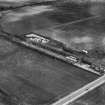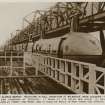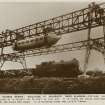Pricing Change
New pricing for orders of material from this site will come into place shortly. Charges for supply of digital images, digitisation on demand, prints and licensing will be altered.
Upcoming Maintenance
Please be advised that this website will undergo scheduled maintenance on the following dates:
Thursday, 30 January: 11:00 AM - 3:00 PM
During these times, some functionality such as image purchasing may be temporarily unavailable. We apologise for any inconvenience this may cause.
Milngavie, Bennie Railplane
Monorail (20th Century)
Site Name Milngavie, Bennie Railplane
Classification Monorail (20th Century)
Alternative Name(s) George Bennie Airspeed Railway; Milngavie, Overhead Railway
Canmore ID 198436
Site Number NS57SE 101
NGR NS 55491 73435
NGR Description centred; NS55436 73425 – c. 55554 73446
Datum OSGB36 - NGR
Permalink http://canmore.org.uk/site/198436
- Council East Dunbartonshire
- Parish New Kilpatrick (Bearsden And Milngavie)
- Former Region Strathclyde
- Former District Bearsden And Milngavie
- Former County Dunbartonshire
This construction was erected in the late 1920s over the track between Milngavie and Hillfoot Stations. Comprising an elevated track and a propellor-driven carriage suspended from a monorail, it was invented by George Bennie, and was intended to travel at up to 120mph.
An initial test run for passengers took place in 1930, but speeds no higher than 50mph could be achieved on the track available. It proved too advanced for the time, and financial backing was not forthcoming. George Bennie died a bankrupt, and his prototype remained in situ until the mid-1950's.
G Stansfield 2003.
Milngavie Station (NS57SE 39) and Hillfoot Station (NS57SE 40) are at NS 5545 7444 and NS 5511 7212 respectively.
Information from RCAHMS (RJCM), 9 January 2006.
The location of the overhead gantry for the line was over an LNER siding leading to Burnbrae Dye Works, off the Milngavie branch railway. The noted speed of 50mph over a section of 130m in length was unlikely.
The railplane probably failed due to the fact that the transport authorities of the day were wary of adopting a system that was unproven along with a hostility to this type of transport by the four main railway companies, rather than lack of financial investment.
George Bennie, born in 1891, had no formal engineering training, the design of the Railplane being undertaken by a consultant engineer, Mr Hugh Fraser.
There is no documentary evidence in the Annual Returns of the Inter-Counties Ltd that Bennie invested his own money and there is no evidence that he died a bankrupt as he went on to establish two new companies after World War Two.
M Thwaite 2005; Information to RCAHMS via e-mail from Mr Malcolm Thwaite, 8 May 2006
(Location formerly entered in error as NS 5540 7346 to NS 5580 7346.)
Note (23 November 2011)
The Bennie Railplane or the ‘George Bennie Airspeed Railway’ (NS55436 73425 – 55554 73446) was built in 1929-30 (opened July 1930) adjacent to Main Street, Milngavie near Glasgow as a proof on concept testing system. The idea was that the railplane would carry passengers above the rail lines moving them more quickly than the slower freight carrying trains below. Designed by George Bennie (1891-1957), the railplane consisted of an elevated track and propeller driven ‘car’. The test track was some 120 metres in length and, together with the car and infrastructure, it was scrapped in the 1950s. Now only the wooden former LNER former good shed (used in running the tests for the railplane, http://dewi.ca/trains/bennie/index.html [retrieved 24 November 2011]) covering an area of 273.6 square metres, remains. The western end of the Burnbrae freight spur and the former goods station is now used as a timber yard.
The test track was constructed over a section of the Burnbrae branch line (freight) of the former LNER Milngavie branch line. The superstructure of the main suspension girder and the carrying rail was fabricated by the Teeside Bridge and Iron Company. These were in the form of two tiers of lattice girders supported by electricity pylon-like structures. The upper of these long lattice girder structures had a guide rail from which was suspended (by means of two flanged wheels), a propeller-driven car. The lower tier of girders also had a guide rail with wheels that stopped the car from oscillating. There was a 4.88m (16ft) clearance (as with railway bridges) to the railway track section below and the superstructure was some 24.4m (80ft) in span at its base. There was an elevated steel and wooden platform (NS55442 73427) from which passengers boarded and left the car.
The bogies, from which the car suspended, were constructed by Watson Mirlees of Glasgow and the car ( (52ft) in length and 2.44m (8ft) in diameter and 6 tons in weight) was built by William Beardsmore, Dalmuir works from the aluminium alloy, duralumin. This alloy (developed in Germany in 1903) was used in dirigible aircraft and in aeroplanes and its successors are still in use today.
‘The George Bennie Railplane’ by Dewi Williams, http://dewi.ca/trains/bennie/index.html [retrieved 24 November 2011]; ‘The George Bennie Railplane System of Transport’, Scottish Screen Archive Ref 1341 http://ssa.nls.uk/film.cfm?fid=1341 [retrieved 24 November 2011]












